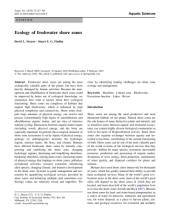
Battered by tides, ice, storms, and human activity, nearly half of New York state's Hudson River shoreline has been “armored up ” by structures such as steel bulkheads or rock revetments. While these structures can protect vulnerable infrastructure in high-energy situations, they also disrupt surrounding habitats. In response, the Hudson River Reserve launched the Sustainable Shorelines project, a long-term, collaborative initiative that is advancing understanding of the engineering, economic, and ecological tradeoffs of using different shoreline management options today—and as the climate shifts and sea levels rise—for generations to come.
About this article
This article, published in Aquatic Sciences in 2010, was written by two members of the project team and provides a comprehensive summary of what is known about the ecological functioning of the shore zone in freshwater ecosystems. The authors discuss the variety of human impacts on the shore zone (e.g., stabilization, simplification, hydrological changes, pollution), reference principles for sustainable shore zone management, provide some information about valuing the different kinds of shore zones, and lastly identify three main gaps in existing knowledge about shore zones.
Strayer, D.L., Findlay, S.E.G., 2010. Ecology of freshwater shore zones. Aquat. Sci. 72, 127-163. https://doi.org/10.1007/s00027-010-0128-9